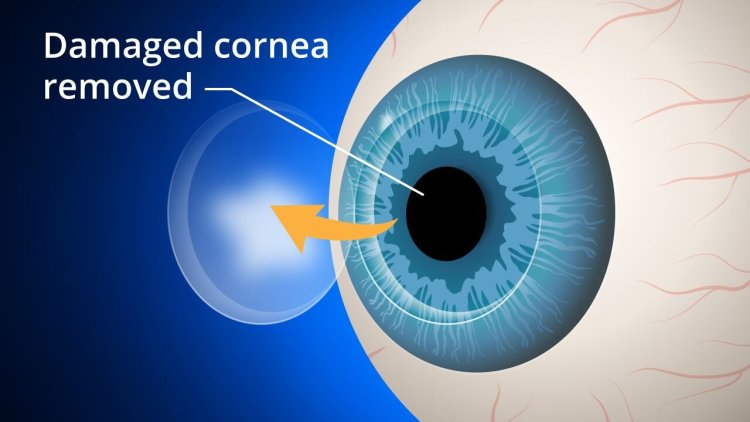You Need to Know About Cornea Transplant
The eye is a wonderful organ in the human body that enables us to comprehend our surroundings.
Share this Post to earn Money ( Upto ₹100 per 1000 Views )

The eye is a wonderful organ in the human body that enables us to comprehend our surroundings. However, various conditions and diseases can affect the clarity of our vision. One such condition is the damage to the cornea, the transparent front part of the eye. When the cornea becomes severely damaged or diseased, a cornea transplant may be necessary to restore vision and improve the quality of life for the affected individual.
What is a Cornea Transplant?
A cornea transplant, also known as corneal transplantation or keratoplasty, is a surgical operation in which a healthy cornea from a donor is used to replace a cornea that has been injured or infected. The cornea is responsible for refracting light and focusing it on the retina, which is crucial for clear vision. When the cornea is damaged due to injuries, infections, or certain medical conditions like keratoconus, it can lead to vision impairment or even blindness.
Reasons for Cornea Transplant
Cornea transplants are performed to address various eye conditions that affect the cornea. Some of the common reasons for a cornea transplant include:
1. Corneal Scarring: Scarring on the cornea due to injuries or infections can lead to distorted vision.
2. Keratoconus: This is a condition where the cornea becomes thin and bulges forward, causing irregular astigmatism.
3. Corneal Degeneration: Certain genetic disorders can cause the cornea to degenerate over time.
4. Fuchs' Endothelial Dystrophy: This is a condition where the cells lining the inner layer of the cornea gradually deteriorate.
5. Corneal Infections: Severe infections that do not respond to medications may require a transplant.
6. Chemical Burns: Chemical injuries to the cornea can cause permanent damage.
7. Corneal Edema: Swelling of the cornea can lead to cloudy vision.
The Procedure
Finding a Suitable Donor
Before the surgery, the patient is placed on a waiting list to find a suitable cornea donor. The donor cornea is thoroughly screened to ensure compatibility and minimize the risk of rejection.
Surgical Process
During the cornea transplant procedure, the patient is given local or general anesthesia to ensure comfort. The surgeon then removes the damaged cornea and replaces it with the donor cornea using sutures or an adhesive. The cornea is carefully positioned and secured to facilitate healing.
Recovery Period
After the surgery, the patient is monitored closely to ensure proper healing. Eye drops and medications are prescribed to prevent infection and reduce inflammation. The complete recovery may take several months, and patients are advised to avoid strenuous activities during this period.
Risks and Complications
Like any surgical procedure, cornea transplant comes with some risks and potential complications. These may include:
· Rejection: The body's immune system may recognize the donor cornea as foreign and try to reject it.
· Infection: Infections can occur after surgery, leading to complications.
· Increased Eye Pressure: Some patients may experience increased pressure within the eye.
· Astigmatism: The cornea may not heal perfectly, leading to astigmatism.
Success Rate and Prognosis
The success rate of cornea transplants is relatively high, with many patients experiencing improved vision and quality of life. However, the prognosis depends on various factors, including the patient's overall health and the underlying condition that led to the need for a transplant.
Preparing for a Cornea Transplant
Medical Evaluation
Before undergoing a cornea transplant, the patient undergoes a thorough medical evaluation to assess their overall health and suitability for the procedure.
Discussing the Procedure
The surgeon explains the details of the surgery, including the risks and benefits, and addresses any concerns the patient may have.
Post-Transplant Care
Medications
Patients are prescribed a regimen of eye drops and medications to prevent infection and reduce the risk of rejection.
Follow-up Visits
Regular follow-up visits with the ophthalmologist are essential to monitor the healing process and address any issues promptly.
Lifestyle Changes
After a cornea transplant certain lifestyle changes may be necessary to promote healing and protect the new cornea. These may include avoiding eye injuries and practicing good eye hygiene.
Alternative Treatments
In some cases, alternative treatments like Intacs or collagen cross-linking may be considered before opting for a cornea transplant. These treatments aim to strengthen the cornea and improve vision without the need for a transplant.
Conclusion
A cornea transplant can significantly improve vision and enhance the quality of life for individuals with corneal damage or disease. While the procedure comes with some risks, advancements in medical technology and surgical techniques have made it a highly successful and viable option. If you are experiencing vision problems due to corneal issues, consult with an ophthalmologist to explore the possibility of a cornea transplant.















